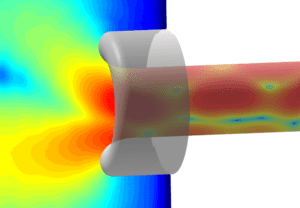Computational Aeroacoustics – CAA
CFD-Berlin has extensive expertise in research and development as well as problem solving in the area of Numerical Aeroacoustics / Computational Aeroacoustics (CAA). Common application cases include sound propagation with flow influence and with sound-absorbing surfaces in areas with complex boundarys, such as inlet or bypass channel of aircraft engines or blowers for industrial and air conditioning (HVAC) applications.
With advanced solvers and in-house tools, we perform optimisations of acoustic absorbers with a high number of parameters > liner optimisation. Our CAA solver CFDNoise is based on the Euler differential equations (linearised / nonlinear) that can be used to simulate sound propagation in flows. A high-order numerical method specially optimised for sound propagation is used for such solutions. In this way, sound sources can be simulated with modal and broadband stimulation. Acoustic absorbers are depicted as an impedance edge condition with flexible freqency dependence. This enables the optimisation of novel liner concepts such as the Special Acoustic Absorber (SAA) Liners, which have a complex variation of its vapour characteristics through complexly shaped resonance spaces, both spatially and in the frequency range, as demonstrated in the image on the left.
as an impedance edge condition with flexible freqency dependence. This enables the optimisation of novel liner concepts such as the Special Acoustic Absorber (SAA) Liners, which have a complex variation of its vapour characteristics through complexly shaped resonance spaces, both spatially and in the frequency range, as demonstrated in the image on the left.
An adjoint solution method is used for gradient-based optimisation of impedance boundary conditions. This enables the efficient calculation of gradients – even with many thousands of parameters. Sensitivity analyses with hundreds of thousands of gradients (point by point) enable groundbreaking insights into the spatial distribution of acoustic absorbers. The simulation can also be applied to points in the farfield, i.e. points outside the computational area.
 Figure: Simulated sound pressure level inside and outside a test bench for axial fans with acoustic absorber. A complex mixture of acoustic modes leads to a strongly directed sound radiation.
Figure: Simulated sound pressure level inside and outside a test bench for axial fans with acoustic absorber. A complex mixture of acoustic modes leads to a strongly directed sound radiation.
